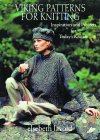
***Viking Patterns for Knitting
Inspiration and Projects for Today's Knitter
by Elsebeth Lavold
Translated by Robin Orm Hansen
Reviewed January 1, 2003.
Trafalgar Square Publishing, North Pomfret, Vermont, 1998.
127 pages.
Available at Sembach Library.
Although I’ve become an avid knitter, especially now that I have
a friend who explores yarn shops with me, I haven’t reviewed a knitting
book before. They aren’t exactly books you sit and read, but I recently
completed a project inspired by this book. I thought it would be
a good excuse to mention it, in case there are any other knitters out there.
The book takes patterns from Viking artifacts and incorporates them
via cable stitches, not color work, into beautiful sweater designs.
Most of the patterns remind me of Celtic designs I saw in Ireland, so
I had a special fondness for them. My real inspiration, though, was
her section on Viking runes.
Anyone who has read
The Hobbit, by J. R. R. Tolkien knows
the important place that dwarf runes take in the story and on Thorin’s
map. He repeats these runes on the cover of several editions, with
title information written in runes around the sides of the cover.
It’s easy to learn the code of certain runes for certain letters.
So I was delighted when Elsebeth Lavold showed me how to knit runes
into a sweater. I used that information with a basic sweater pattern
and designed a sweater that says “All that is gold does not glitter”
in dwarf runes for my teenage son. I finished it in the nick of
time for him to wear it to
The Two Towers movie. There are
a few dwarf runes that aren’t from actual Viking runes, but it was easy
to puzzle them out from the principles that the author gives. The
sweater turned out magnificently, with a pattern from an old Viking sword
accenting the sleeves.
The patterns aren’t nearly as difficult to knit as they look.
The design is done with cables, and you really only need to pay special
attention when the cables are crossing. I definitely want to knit
some more patterns from this book.
My only complaint with the book is that for many of the fourteen
projects, not much yarn information is given. In several cases,
only the name of the yarn is given, with no information as to its construction
(wool or cotton) or thickness. Still, you can figure out a lot of
that from the gauge, which is given, so I’m hoping I can find yarn that will
work for some of these designs.
I do appreciate it that she goes beyond the individual sweater patterns
and gives the principles behind making the designs so that you can knit
your own ideas with the Viking patterns. For example, she could
have only given patterns for the particular runes she uses, but instead
she gives the entire runic alphabet and explains the principles that were
used to make them. A beautiful and inspiring book.
Copyright © 2003 Sondra Eklund.
All rights reserved.
-top of page-